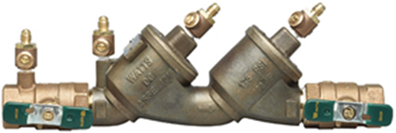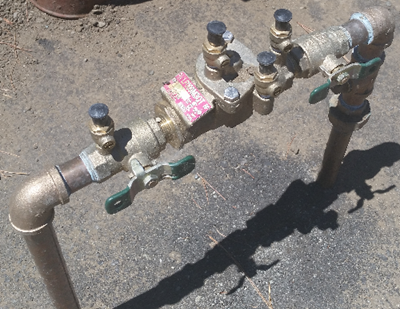SECTION 1. PUBLIC WATER SYSTEM CONTACTS.
NOTE: A person may be assigned multiple contact types. For example, the owner may also be both the Administrative Contact and Financial Contact.
SECTION 2. POPULATION SERVED.
SECTION 4. GROUNDWATER (GW) AND SURFACE WATER (SW) SOURCES.
SECTION 6. WATER RATES AND DELIVERIES.
SECTION 8. WATER TREATMENT.
SECTION 9. CROSS-CONNECTION CONTROL.
 |
 |
| Fig. 1 - a double check valve assembly | Fig. 2 - a reduced pressure principle backflow prevention assembly |
SECTION 10. CONSUMER CONFIDENCE REPORT.
SECTION 11. OPERATOR CERTIFICATION.
This shows the classification of your treatment facility with the highest classification (T1, T2, T3, T4, or T5). However, you may see the following instead:
- Treatment or Distribution Operator – your treatment facility or facilities may be operated by either a certified treatment or distribution operator
- Classification is Unavailable – the classification of your treatment facility or facilities has not been entered into the Division’s SDWIS database
- No facilities subject to the Certified Treatment Plant Operator requirements – either you do not have any treatment facilities or these treatment facilities are not subject to the certified treatment plant operator requirements.
If you believe that your highest treatment facility classification is in error, please notify your local regulatory agency immediately.
This shows the classification of your distribution system (D1, D2, D3, D4, or D5). However, you may see the following instead:
- Distribution Operator Not Required – your water system is a transient non-community water system and as such is not subject to the certified distribution system operator requirements
- Classification is Unavailable – the classification of your distribution system has not been entered into the Division’s SDWIS database
If you believe that your highest treatment facility classification is in error, please notify your local regulatory agency immediately.
- If you do not have any certified operators to report, put “NONE” in each column of the first row.
Name Grade of
OperatorChief or Shift1 (C/S) Operator
NumberExpiration Date NONE NONE NONE NONE NONE - - - - - - Use the following format and rules to complete the State certified Water Treatment Plant Operators table:
1Use “C” for Chief Operator and “S” for Shift Operator. If neither, leave blank.Name Grade of
OperatorChief or Shift1 (C/S) Operator
NumberExpiration Date First Last T1, T2, T3, T4, or T5 only. C or S only (lowercase ok); leave blank if neither. 4 or 5 digits MM/DD/YYYY - - - - - - Use the following format and rules to complete the State certified Water Distribution System Operators table:
1Use “C” for Chief Operator and “S” for Shift Operator. If neither, leave blank.Name Grade of
OperatorChief or Shift1 (C/S) Operator
NumberExpiration Date First Last T1, T2, T3, T4, or T5 only. C or S only (lowercase ok); leave blank if neither. 4 or 5 digits MM/DD/YYYY - - - - -
SECTION 14. SYSTEM PROBLEMS